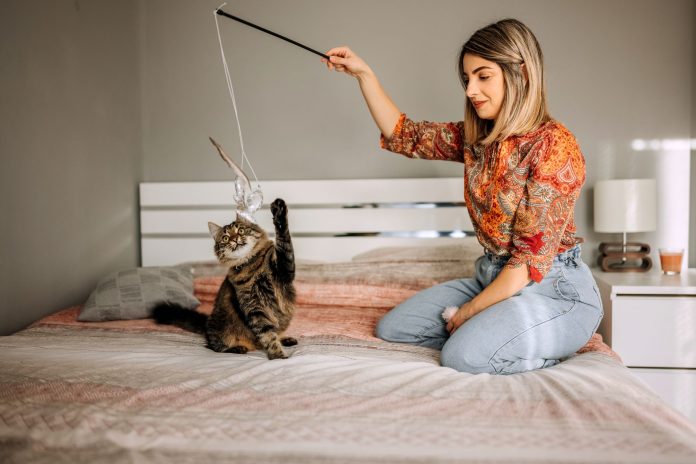When it comes to keeping our feline friends healthy and happy, exercise is a crucial piece of the puzzle. While cats might not need exercise as intensely as dogs, they still require it to maintain their health, prevent obesity, and keep their minds sharp. However, over exercise can be dangerous for cats, especially to senior or ill cats. Thus, always consult your vet at Virginia Beach veterinary clinic before introducing any new form of exercise to your cat.
Let’s explore just how much exercise cats need and how you can make sure your kitty stays active and engaged.
Understanding Cat Exercise Needs
Unlike dogs, who often require regular walks and outdoor play, cats are naturally more independent and may not always show a clear desire for exercise. However, all cats, whether they’re indoor-only or have access to the outdoors, need physical activity to stay fit and mentally stimulated.
Cats have evolved as natural hunters. In the wild, they would spend much of their day stalking prey, climbing trees, and exploring their territory. Even though domestic cats don’t need to hunt for their meals, they still have those instincts, and exercise helps satisfy them.
How Much Exercise Is Enough?
The amount of exercise a cat needs can vary based on several factors, including their age, breed, health status, and activity level. Generally, a few short play sessions each day are sufficient for most cats. Here’s a more detailed look:
- Kittens: Kittens are bundles of energy and need a lot of playtime. Their exercise often comes from their natural playful behavior, including chasing toys, climbing, and pouncing. Aim for at least 20-30 minutes of active play a few times a day. Their play sessions should be interactive and varied to help them develop their coordination and social skills.
- Adult Cats: For adult cats, 15-20 minutes of playtime each day is generally enough. This can be broken into multiple shorter sessions throughout the day. Engaging in activities that mimic hunting behaviors, like using feather wands or laser pointers, can be particularly effective.
- Senior Cats: Older cats might not have the same energy levels as their younger counterparts, but they still need exercise to maintain their mobility and prevent weight gain. Gentle play and interactive toys that don’t require a lot of jumping or running can be great for senior cats. Aim for shorter, more frequent play sessions—about 10-15 minutes, 1-2 times a day.
Tips for Encouraging Exercise
1. Use Interactive Toys: Toys that stimulate a cat’s hunting instincts are ideal. Wand toys, laser pointers, and toys that dispense treats can keep a cat engaged and active. These toys provide mental stimulation and physical exercise, helping to keep your cat’s body and mind sharp.
2. Create Vertical Spaces: Cats love to climb and explore. Providing cat trees, shelves, and other vertical spaces allows them to exercise in a natural way. Climbing is great for their muscles and helps them feel more secure and entertained.
3. Play Hide and Seek: Hide treats or toys around the house to encourage your cat to search for them. This not only gets them moving but also stimulates their natural hunting instincts. It’s a great way to keep them active without requiring constant supervision.
4. Engage in Regular Playtime: Set aside time each day to play with your cat. Consistent playtime helps maintain their fitness and strengthens your bond. Whether it’s a few minutes with a toy or a longer play session, regular interaction is key.
5. Provide Opportunities for Solo Play: While interactive play is important, giving your cat toys they can play with alone helps ensure they stay active when you’re not around. Puzzle toys that dispense treats can keep them engaged and moving.
Expert Insight: Why Exercise Matters
“Exercise is not just about preventing obesity; it’s also crucial for mental stimulation,” says Dr. Wayne M. Johnson. “Cats that don’t get enough physical activity can become bored, stressed, or even develop behavioral issues. Regular exercise helps maintain a healthy weight, keeps their muscles strong, and provides a way for them to express their natural behaviors.”
Additionally, exercise can help prevent common health issues such as diabetes, arthritis, and urinary tract problems. “A well-exercised cat is less likely to suffer from these conditions,” Dr. Johnson adds. “Maintaining an active lifestyle contributes to a better quality of life and can help your cat live a longer, healthier life.”
Recognizing the Signs of Insufficient Exercise
If you notice any of the following signs, it might indicate that your cat isn’t getting enough exercise:
- Weight Gain: Obesity is a common issue in sedentary cats. If your cat is gaining weight, it’s a sign they might need more physical activity.
- Behavioral Issues: Cats that are bored or stressed may exhibit destructive behaviors, such as scratching furniture or excessive meowing. Increased activity can help alleviate these issues.
Lethargy: A lack of energy or enthusiasm for play can indicate that your cat isn’t getting enough exercise. However, if this persists, it’s important to rule out health problems with your vet at veterinary clinics in Virginia Beach.
Conclusion
Keeping your cat active is essential for their physical and mental well-being. By understanding their exercise needs and providing a variety of stimulating activities, you can ensure your feline friend stays healthy, happy, and engaged. Remember, regular play and exercise are key components of a balanced lifestyle for your cat, so make it a fun and rewarding part of their daily routine.








